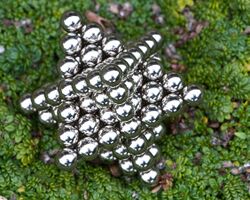124 (number)
From HandWiki
Short description: Natural number
| ||||
|---|---|---|---|---|
| Cardinal | one hundred twenty-four | |||
| Ordinal | 124th (one hundred twenty-fourth) | |||
| Factorization | 22 × 31 | |||
| Divisors | 1, 2, 4, 31, 62, 124 | |||
| Greek numeral | ΡΚΔ´ | |||
| Roman numeral | CXXIV | |||
| Binary | 11111002 | |||
| Ternary | 111213 | |||
| Quaternary | 13304 | |||
| Quinary | 4445 | |||
| Senary | 3246 | |||
| Octal | 1748 | |||
| Duodecimal | A412 | |||
| Hexadecimal | 7C16 | |||
| Vigesimal | 6420 | |||
| Base 36 | 3G36 | |||
124 (one hundred [and] twenty-four) is the natural number following 123 and preceding 125.
In mathematics
124 is an untouchable number, meaning that it is not the sum of proper divisors of any positive number.[1]
It is a stella octangula number, the number of spheres packed in the shape of a stellated octahedron.[2] It is also an icosahedral number.[3]
There are 124 different polygons of length 12 formed by edges of the integer lattice, counting two polygons as the same only when one is a translated copy of the other.[4]
124 is a perfectly partitioned number, meaning that it divides the number of partitions of 124. It is the first number to do so after 1, 2, and 3.[5]
See also
- The year AD 124 or 124 BC
- 124th (disambiguation)
- List of highways numbered 124
- All pages with titles containing 124
References
- ↑ Sloane, N. J. A., ed. "Sequence A005114 (Untouchable numbers, also called nonaliquot numbers: impossible values for the sum of aliquot parts function)". OEIS Foundation. https://oeis.org/A005114.
- ↑ Sloane, N. J. A., ed. "Sequence A007588 (Stella octangula numbers)". OEIS Foundation. https://oeis.org/A007588.
- ↑ Sloane, N. J. A., ed. "Sequence A006564 (Icosahedral numbers)". OEIS Foundation. https://oeis.org/A006564.
- ↑ Sloane, N. J. A., ed. "Sequence A002931 (Number of self-avoiding polygons of length 2n on square lattice (not allowing rotations))". OEIS Foundation. https://oeis.org/A002931.
- ↑ Sloane, N. J. A., ed. "Sequence A051177 (Perfectly partitioned numbers: numbers k that divide the number of partitions p(k))". OEIS Foundation. https://oeis.org/A051177.
 |


